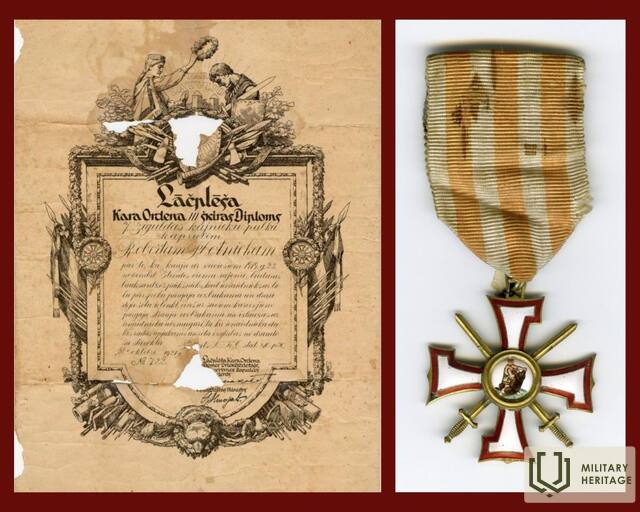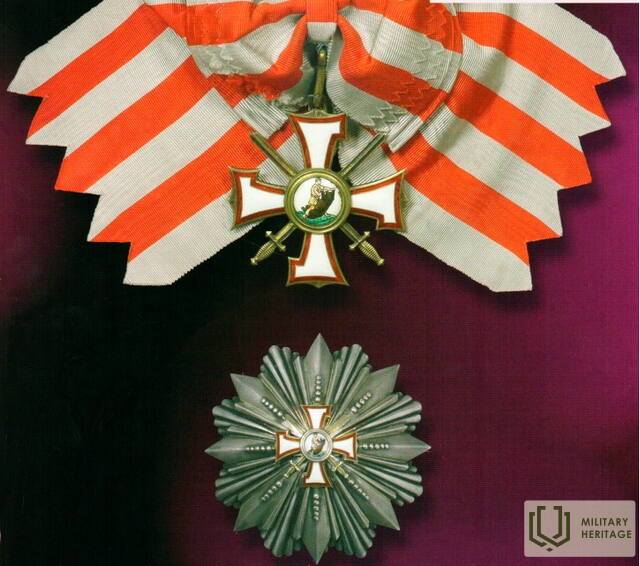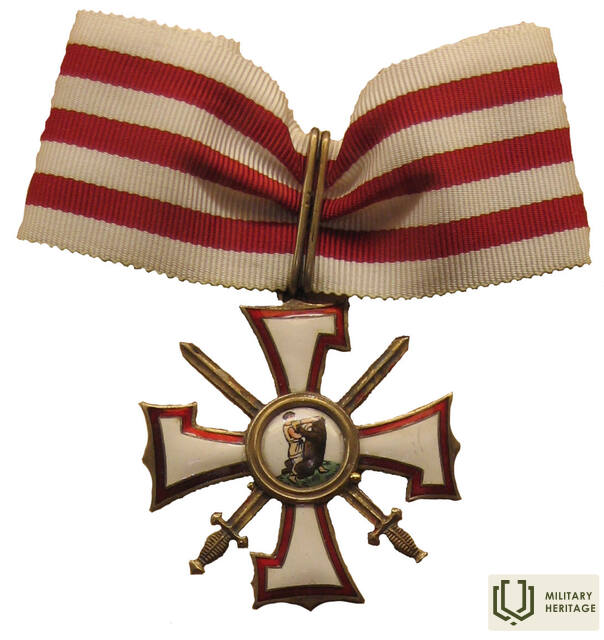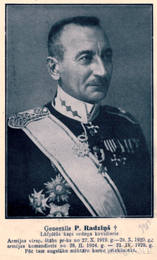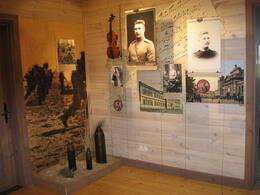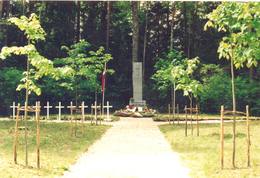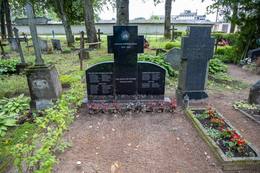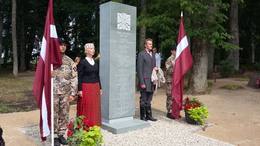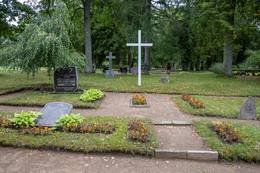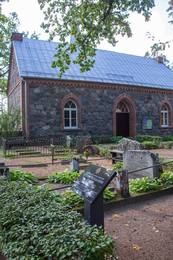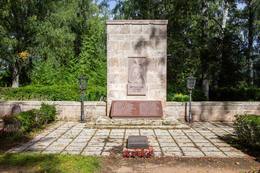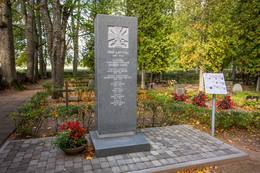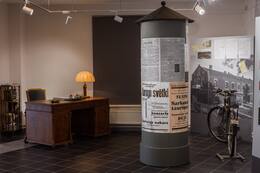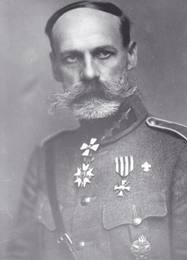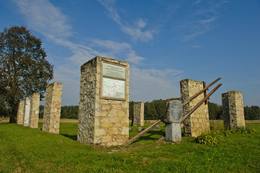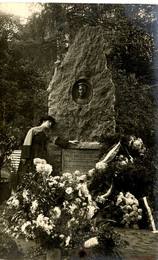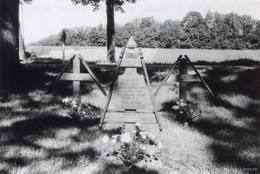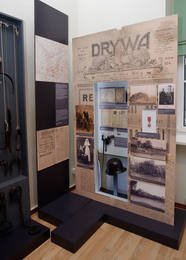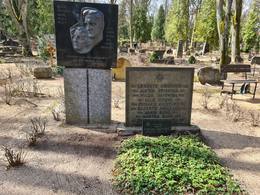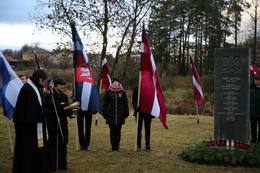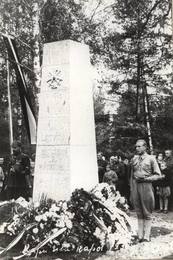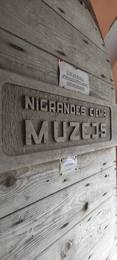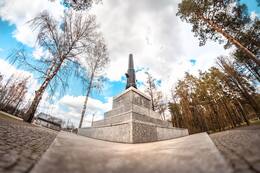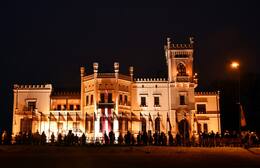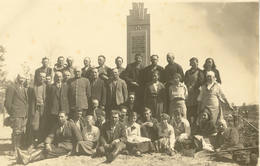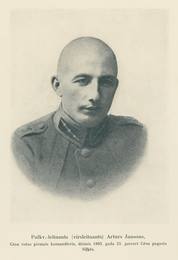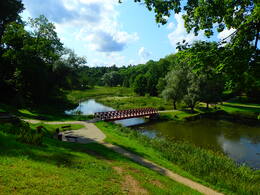Order of Lāčplēsis I WW1, I Wars of Independence
The highest Latvian military award - the Lāčplēsis War Order - was founded on November 11, 1919 in honor of the defeat of the Bermontians on the banks of the Daugava and the liberation of Riga. The Lāčplēsis War Order also became the first Latvian state award. However, November 11, 1919 is the symbolic date of the establishment of the order, because the statutes of the order were approved by the Latvian Constitutional Assembly on September 18, 1920. The first award ceremony took place a year after the liberation of Torņakalns on November 11, 1920 on the Esplanade. It was awarded to Latvian army soldiers, former Latvian riflemen and foreigners, honoring their contribution to Latvia's independence. The first Lāčplēsis War orders were received by: General Pēteris Radziņš, Colonels and Lieutenant-Colonel Mārtiņš Peniķis, Krišjānis Berķis, Jūlijs Jansons, Jānis Apinis, Oskars Dankers and Jānis Puriņš.
The badge of the Lāčplēsis War Order is a white enameled fire cross with a red and gold border. On the obverse of the center medallion is Lāčplēsis, which is fighting a bear. Cross corners - crossed swords. The date is placed on the reverse medallion - "November 11, 1919". Engraved in the branches of the cross is "For Latvia", which is the motto of the Order. The initials HB are engraved on the ends of the cross - a masterpiece of the silversmith Hermann Bank. The Order has a multi-beam silver star with the Order badge in the center. Moire ribbon with three red and four silver stripes of equal width. The Lāčplēsis War Order has three classes - Class I, II and III.
The awarding with the Lāčplēsis War Order lasted until November 11, 1928. During these eight years, the 1st Class Lāčplēsis War Order was awarded to 11 persons (4 Latvians and 11 foreigners), the 2nd Class Order to 61 persons (18 Latvians and 43 foreigners), and the 3rd Class Order to 2,072 persons (1,600 National Army soldiers, 202 former Latvian riflemen). and 271 foreigners). LKO cavalry enjoyed a number of privileges - the right to wear a military uniform even after vacation, discounts on the purchase of railway tickets, the right to receive exemption from tuition fees for children in public schools, free medical care, etc.
A total of three women were awarded the Lāčplēsis War Order. One of them is the famous Latvian rifleman Līna Čanka, whose life story has already become legendary. Born in 1895 in Mežzīle, Renda Parish, in 1915, approaching the German army, L. Čanka left his family home with his family and went on to run as refugees. Arriving in Riga, she made a decision uncharacteristic of the era - to fight the invading army with a weapon in the hands of the Latvian Rifle Battalion. Using the documents of the deceased brother Jānis and the favor of a well-known guy who successfully passed the medical commission, L. Čanka manages to get into the 3rd Kurzeme Latvian Rifle Battalion. However, very soon L. Chanka's service members reported to the command about the rifleman with unusual behavior. When everything came to light, Chancu wanted to be expelled from the battalion, but she protested, expressed a desire to fight the enemy and even threatened to shoot himself. As a result, L. Chanka was allowed to remain in the battalion.
More information sources
Sargs.lv. 2015. Latvian Riflemen - Knights of the Lāčplēsis Military Order. Available: https://www.sargs.lv/lv/vienibas-un-personibas/2015-11-23/latviesu-strelnieki-lacplesa-kara-ordena-kavalieri#lastcomment [accessed 06.05.2021].
Blizzard of Souls. Lāčplēsis War Order, 1919-1928. Available: https://www.dveseluputenis.lv/lv/laika-skala/notikums/124/lacplesa-kara-ordenis-1919-1928/ [accessed 06.05.2021].
Sargs.lv. 2011. Lāčplēsis War Order. Available: https://www.sargs.lv/lv/vesture/2011-04-18/lacplesa-kara-ordenis#lastcomment [accessed 06.05.2021].
Historia.lv. 2014. Lāčplēsis War Order. Available: https://www.historia.lv/biblioteka/skirklis/lacplesa-kara-ordenis [accessed 06.05.2021].
Related timeline
Related objects
Memorial place of General Pēteris Radziņš
Located in Valka parish, driving on the road Valka - Rūjiena (P22) 4 kilometers, to the right, following the signs.
Pēteris Radziņš was born on May 2, 1880 in Lugavis Parish, Jaunvīndedze. Studied at Lugaži Parish School, Valka City School and Valka Nelson Real School. Joined the Russian army as a volunteer. In the autumn of 1919, he returned to Latvia and on October 27 was appointed Chief of Staff of the Commander-in-Chief of the Army, assuming this position at a time when the...
Oskars Kalpaks Museum and Memorial Site “Airītes”
The Oskars Kalpaks Museum and Memorial Site Airītes is located between Saldus and Skrunda near the A9 highway. The exhibit has extensive information about Colonel Oskars Kalpaks and his battalion, and shows the history of the Latvian National Army and the memorial site Airītes. The exhibit reveals Colonel Oskars Kalpaks as a personality, as a soldier and as a fighter for Latvia's independence. Audio logs in Latvian, English and German are also available as part of the exhibit. They emphasize the importance of the historic events of 1918/1919 in the protecting the statehood of Latvia. The museum building has been restored.
...Alūksne Garrison Cemetery
Located on the shores of Lake Alūksne, on the Kapsēta peninsula, in the territory of the Great Cemetery.
They were started and maintained by the soldiers of the 7th Sigulda Infantry Regiment in the 1930s and consecrated on November 11, 1932. After the restoration of Latvia's independence, Uldis Veldre, the head of the department of the Alūksne Brothers' Cemetery Committee, took care of the maintenance of the Garrison Cemetery, the identification of the resting places associated...
Karvas Brothers Cemetery
It is located on the side of Alūksne - Ape road near the Eel House, south of Karva, turning to Rezaka.
The monument was unveiled on September 12, 1937. The granite stencil was designed by Oem Dambekalns in Riga in Riga by the architect Vemera Vitand.
In the autumn of 1975, the local communists destroyed the monument. On March 30, 1989, the Alūksne District Council decided to restore the monument, and on April 30, 1989, a temporary...
Monument to the participants and fallen of the War of Independence
Located in the Center Cemetery, Barkava Parish, Madona Region.
Not far from Barkava St. Stanislaus Roman Catholic Church.
A monument to the participants and victims of the Latvian War of Independence can be seen. The monument was unveiled on November 11, 2018. It was initiated by Janīna Liepiņa, a history...
Memorial to the Knights of the Lāčplēsis War Order
Located in Matīši cemetery, Matīši parish.
A text with the names of the 15 Knights of the Lāčplēsis Military Order related to Matīši, as well as with the neighboring parishes of Vilzēni and Braslava, who were once united by the parish of Matīši Church, is engraved on the memorial table. Those who died abroad or were buried elsewhere in Latvia were also identified, but here in Matīši there is a family cemetery...
Burials of Latvian legionnaires and victims of the War of Independence
Located in Cesvaine Ķinderi cemetery.
A granite memorial stone to Latvian legionnaires was unveiled in the cemetery of the Brothers in June 1997, and the individual burials of the fallen in the War of Independence can be found and seen...
Burials of the Knights of the Lāčplēsis Military Order in Palsmane cemetery
Located in Palsmane cemetery.
There are 7 cemeteries of the Knights of the Lāčplēsis War Order.
...
Monument to the Smiltens who died in the War of Independence
Located in Smiltene Lutheran Cemetery, 11 Valnu Street.
The monument to the Smiltene victims of the War of Independence was unveiled and consecrated on November 7, 1937. The monument is built of concrete and lined with Allaži limestone slabs. The monument is based on the sketch of architect Werner Vitand and the sculptor Matiss Pluck...
Memorial places for generals and knights of the Lāčplēsis War Order in Trikāta Parish
The memorial stele is located next to the Trikāta cemetery chapel.
Trikāta Cemetery preserves the memory of three outstanding Latvian generals - Roberts Dambītis, Kārlis Goppers and Jānis Balodis. Jēkabs Mūrnieks, a teacher of all these generals, is also buried in Trikāta cemetery...
Memorial to the Knights of the Lāčplēsis War Order
Located next to the chapel of Kauguri cemetery.
A memorial stall and information stand with a biography of each knight of the Lāčplēsis War Order, places of struggle and a place of rest can be seen...
Exposition "Latvian Army in Pļaviņas in the 20th Century"
Located at Odzienas Street 2, Pļaviņas.
The permanent exposition "Latvian Army in Pļaviņas in the 20th Century" can be seen.
...General Karl Gopper Memorial Room in the Muscat Hometown
Located in Plāņi Parish on the bank of the Vija River.
The memorial room of General Karl Gopper in his native house "Muscat" can be seen...
Memorial to the Victims of Communist Terror for the Repressed in Jaunrauna Parish
Located in "Baižēni", Priekuli parish
A memorial place for the repressed was created in the place of the ruins of the barn of the "Baižēni" house, where on the night of March 25, 1949, 40 residents of Jaunrauna parish were kept to take their way to Lode railway station and Siberia in the morning...
Lubāna Municipality tourism and cultural heritage centre
The Lubāna Municipality Tourism and Cultural Heritage Centre is located in the very centre of the city of Lubāna. It features several exhibits, including permanent ones, on the history, culture and traditions of and events at the municipality. The permanent exhibits are dedicated to personalities that Lubāna is especially proud of. They introduce poet Broņislava Martuževa, member of the National Resistance Movement and political prisoner; politician Hugo Celmiņš, a participant of the War of Independence; Oskars Kalpaks, First Commander-in-Chief of the Latvian Army; photographer Alfreds Grāvers; opera singer Jānis Zābers; poet Jānis Gavars; artist Rūdolfs Pinnis, as well as folklorist and pastor Mārtiņš Celmiņš. A guide describes the lives of the Knights of...
Monument to the soldiers who died in the War of Independence
Located in Valka on Varoņu Street next to the Forest Cemetery.
A monument to 30 soldiers of the 1st (4th) Valmiera Infantry Regiment who died in the Latvian War of Independence can be seen.
...
Monument to the sea lieutenant, L.k.o.k. Vilis Gelb (1890-1919)
Located in Limbažu Jūras iela cemetery, Jūras iela 56, Limbaži
The monument opened on September 10, 1922 by the then President of Latvia Jānis Čakste, on which the dedication of the poet Viļas Plūdonis to Vilis Gelb is read:...
In Vidriži, a memorial sign at the place where LKOK Vilis Gelbe and two soldiers of his team fell
In Vidriži, at the turn to Lēdurga, during the Freedom Struggle on June 19, 1919, Marine First Lieutenant Vilis Gelbe and two soldiers fell in battle.
Vilis Gelbe is buried in the Limbaži cemetery. Vilis Gelbe was awarded the III class of the Lāčplēš War Order (No. 895) for his heroic deed at Vidrižu manor...
Preiļi Museum of History and Applied Art exhibition "Museum stories for Latvia"
It is located in the premises of the Preiļi Cultural Center.
Preiļi Museum of History and Applied Art (PVLMM) exhibition "Museum stories for Latvia" about the First World War, the War of Independence and the Second World War can be viewed...
Monument to the first fallen soldier of the Schoolmen's Company, Edgars Krieviņas
Located in the Central Cemetery of Valmiera, near the chapel (Miera Street 1/3, Valmiera)
A soldier of the 8th (Skolnieki) company of the Cēsi regiment, LKOK Edgars Krieviņš (1899-1919), died on June 7 from injuries sustained in the battles of Cēsi on June 6, 1919, when he covered the retreat of the rest of the units when the Landsweer attacked.
Memorial stele for the knights of the War Order of Lāčplēš
It is located next to the Roman Catholic Church of the Heart of Jesus in Viļaka.
The memorial stele for the knights of the Lāčplēš War Order in Viļakas region was opened on November 11, 2017. The destinies of 28 Lāčplēš Knights of the Military Order are connected with the name of Viļakas county.
...
Barn of Nygrande Manor
The Nīgrande Local History Repository is located in the Nīgrande village in the manor barn, next to the Nīgrande Primary School, and is accessible by appointment.
The military history section of the repository includes an exhibition on World War II and original objects and parts found in the area after the war and in later years. You can also find out stories and see photographs about Nygrande and its surroundings from the War of Independence, World War II and the post-war period, as well as life on the collective farm in Soviet times.
...Monument to the Liberation of Livani
The monument is located at the intersection of Fabrikas and Stacias streets, where it was opened on June 9, 1935 by General Rudolfs Bangerskis, honoring the memory of the soldiers who fell in the battles for the liberation of Lebanon in 1919.
Its main element is a 15-ton, vertically placed cannon barrel. In 1958, the Soviet power dismantled the symbol of the freedom of Lebanon, cutting the barrel of the cannon into scrap metal. The inhabitants of the cannon ball remained throughout the Soviet years, and they returned to their previous place after half a century. The idea of restoring the monument was alive in the people...
Alūksne Museum
The Alūksne Museum is located in an architectural monument of national significance: the neo-Gothic Alūksne New Castle built in the late 19th century. The museum features an exhibition named ‘Memorial Room for Victims of the Totalitarian Regime’, which tells about the fate of the inhabitants of Alūksne municipality in Siberia and the Far East, while the time periods from prehistory to the present meet in the Alūksne history exhibit ‘Feast of the Ages’. It features a separate section devoted to the contribution of the 7th Sigulda Infantry Regiment to the military, culture and public life. The formation of the 7th Sigulda Infantry Regiment began on 20 June 1919 in the Naukšēni Manor. Initially, a battle group of 22 officers and 1,580 soldiers was formed...
Monument to the soldiers of Anna Parish who died in the First World War and the Latvian Liberation War
Located in the central part of Anna parish Ezeriņi cemetery.
In the cemetery, where the burials have been made since 1925, there is a monument to the soldiers of Anna Parish who died in the First World War and the Latvian Liberation War, built with the funds collected by the Department of Guard of Anna Parish and unveiled in 1933. Until the Second World War, the guards of Anna Parish took care of the care of the monument, who went to the...
Monument to Cēsis ornaments at the site of the first battle
Located in Drabešu parish, 79th kilometer of Vidzeme highway.
A monument made of granite can be seen, in which a stylized scheme of the invasion of the Bolsheviks was carved.
The monument has been discovered and consecrated. December 28, 2018. In Drabešu Parish, on December 24, 1918, the reconnaissance team of Captain Artūrs Jansons (1893 - 1941)...
Misiņkalns Military Heritage Trail
Misiņkalns nature park is located in the town of Aizpute. Misiņkalns is the highest place in the city of Aizpute. Its height reaches 95.4 m. The top offers a scenic view of the city. Misiņkalns nature park was started to be built in the 20th century. at first. The area of the park is currently about 28 ha.
In the territory of the park there are several places and memorials related to the events of the 20th century - the memorial stele of the soldiers who died in the Latvian Freedom Wars - the...
Steles in memory of the knights of the War Orders of Lāčplēš
Twenty-seven knights of the Lāčplēš Military Order are associated with the Aizpute region.
Commemorative stelae of a uniform pattern were erected throughout Latvia in honor of the soldiers who fell in the Latvian Freedom Struggle, in which the text engraving font corresponds to the standard of the heroes' memorial plaques, which is analogous to the engraving of the sandstone memorials of the Riga Brothers' Grave and Central Graveyard...
Stele "To the Heroes of the War of Independence" in Jaunjelgava
A memorial plaque is dedicated to the knights of the Lāčplēsis War Order born in the Jaunjelgava region. The stele was unveiled on November 2, 2017. The names and years of life of the knights of the Lāčplēsis Order who came from the specific region are engraved on the approximately two-meter-high memorial plaque. On the other side of the stele is the text: “To the Heroes of the Latvian Freedom Struggle on the Centenary of Latvia”...
Memorial site of General K. Berkis
A monument to General Krišjānis Berķis (1884 - 1942) was erected on the site of his birthplace near an oak tree. The monument was erected by the Latvian National Soldiers' Association at its own expense on April 26, 1998. Kr. Berķis was a general of the Latvian Army, commander of the Latvian Riflemen, fought in World War I and the Latvian War of Independence. Cavalier of the Lāčplēsis War and Three Star Orders. Commander of the Latvian Armed Forces, Minister of War of Latvia...
Related stories
Liberation of Northern Latgale from the Bolsheviks
On December 1, 1918, parts of the Red Army, based on the Red Rifle units, invaded the territory of Latvia. In order to protect their homes, families, native counties and escape from terror, the men around Balvi took up arms and went into the forests, and the first "green" groups began to form. In the spring of 1919, when the mobilization was announced, many men in the Balvi area were not allowed to fight in the Soviet Latvian army and they joined the "green" groups. Balvi, Silakrog, Rugāji, Teteru-Dūrupe and Liepna groups were formed. In the vicinity of Balvi, the activity of "green" groups became more active in March 1919.
About the National Patriot Chief Lieutenant Vili Gelbi
The fate of Senior Lieutenant Viļa Gelbe (1890-1919) reflects the difficult situation in the formation of our country and army, as well as in the evaluation of these events.
With the proclamation of the Latvian state on November 18, 1918, the War of Independence and the work of forming the armed forces also began. Vilis Gelbe, a naval lieutenant born in Kurzeme, was in the front ranks of Latvian volunteers.
For the first Commander-in-Chief of the Latvian Army David Simanson
The essays of the book "Latvian Army Commanders" convince that history is significantly influenced by specific people. Although at the epicenter of the most important historical events for a short time, the true Latvian patriots, with their rich military experience, managed to accomplish a lot in the formation and strengthening of the Latvian army and the turn of historical events.
This story is about the first commander-in-chief of the Latvian army, David Simanson (1859-1933).
Awarding of the 7th Sigulda Infantry Regiment in bermontiad, awarding of the great soldier Valija Veščūnas with the Lāčplēsis War Order in Alūksne
After the Latvian War of Independence, the great soldier Valija Veščunas was awarded the Lāčplēsis War Order for the November 19, 1919 battles with the Bermontians at the Plan House. Valija Veshchun was one of the first to cross the Lielupe under the fire of the enemy.
Memorial moment in the Garrison Cemetery
After the restoration of Latvia's independence, Uldis Veldre, the head of the department of the Alūksne Brothers' Cemetery Committee, took care of the maintenance of the Garrison Cemetery, the identification of the LKOK-related resting places related to Alūksne and the installation of memorials in the Garrison Cemetery.
About General Karl Gopper
General K. Goppers (1876-1941) was an outstanding soldier and an outstanding man. He stood out as a successful commander who took over the command of the battalion and regiments, heroically leading his riflemen in battles for the freedom of Latvia during the First World War (1914-1919). He has participated in battles in Tīreļpurvs, Ložmetējkalns, and defended Riga.
The life of General Jānis Balozis after returning from deportation
When the Russians tried to force a military base agreement from the Latvian government in 1940, which would make the Latvian army's resistance to the Red Army almost impossible, General J. Balodis tries to get some amendments to this agreement. But it fails. But the general's bad guys use this circumstance to later correct J. Balodi almost as a traitor. After a conflict with the Prime Minister of the State and Prime Minister K. Ulmanis, on April 5, 1940, the General was relieved of the post of Minister of War. Then J. Balodis decides to participate in the Saeima elections from the Democratic Bloc, but nothing comes out of it, because only one list may stand for election - the list of communist candidates. Latvia becomes the 14th Soviet republic.
In memory of Pēteris Radziņš, General of the Latvian Army, two-time Knight of the Lāčplēsis War Order
General Pēteris Radziņš, born in Lugka Parish, Valka District, in a simple farmer's family, where he learned to do field work. He was a very smart young man, after graduating from school he decided in favor of the war and it started his army rescue of Latvia from Bermont's troops. P.Radziņš was one of the most outstanding officers of the Latvian Army and was awarded with numerous Latvian and foreign orders and memorials.
Aizporu half manor in the War of Independence
Aizporu Half Manor, Aizpute district, Kalvene municipality, is the westernmost place in Latvia to which Colonel Oskars Kalpaks' separate battalion retreated.
Halfway between Rudbārži and Kalvenė, on the side of the road, is the Aizpore cemetery. There is a monument and 12 memorials to the volunteer soldiers of Oskars Kalpaka's battalion.
Historical evidence in the rocks of Līču - Langģi
Excerpts from local history enthusiast Aivars Vilnius tell about history and its evidence found in Lode and Liepa, now in Cēsi county.




